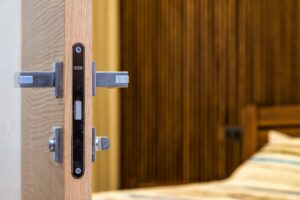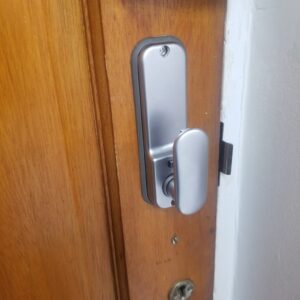When choosing a wooden door for external use, it’s important to select a wood species that is naturally resistant to rot, decay, and insect damage. Some of the best types of wood for external doors include the next four:
- Cedar is a softwood that is naturally resistant to rot and insect damage. It is also relatively lightweight, which makes it easy to work with and install.
- Mahogany is a hardwood that is known for its durability and resistance to rot and insects. It has a tight grain and a rich, reddish-brown colour that makes it a popular choice for high-end doors.
- Teak is a tropical hardwood that is highly resistant to rot and decay, even when exposed to outdoor conditions. It is also resistant to termites and other wood-boring insects.
- Redwood is a softwood that is naturally resistant to rot and decay, and it is commonly used for outdoor construction and furniture. It has a reddish-brown colour and a straight grain that makes it a popular choice for doors.
Regardless of the type of wood you choose, it’s important to properly seal and finish the door to protect it from the elements and extend its lifespan. This can include applying a protective sealant, staining or painting the wood, and regularly inspecting the door for signs of damage.
 Wooden doors have several benefits that make them a popular choice for many homes and buildings. The natural beauty and warmth can enhance the aesthetic of any space. Also, they come in a wide variety of styles and designs, and the natural grain and colour of the wood can add character and charm to any room. Wood is a strong and durable material that can withstand regular use and wear and tear. Well-made wooden doors can last for many years, making them a long-lasting and cost-effective choice. Wood too is a good insulator, and wooden doors can help to keep heat in and cold out, which can help to reduce energy costs and improve the comfort of your home and can be customized to fit almost any size or shape of the opening, and they can be stained or painted to match the existing decor of your home. This makes them a versatile and flexible option for many different types of buildings.
Wooden doors have several benefits that make them a popular choice for many homes and buildings. The natural beauty and warmth can enhance the aesthetic of any space. Also, they come in a wide variety of styles and designs, and the natural grain and colour of the wood can add character and charm to any room. Wood is a strong and durable material that can withstand regular use and wear and tear. Well-made wooden doors can last for many years, making them a long-lasting and cost-effective choice. Wood too is a good insulator, and wooden doors can help to keep heat in and cold out, which can help to reduce energy costs and improve the comfort of your home and can be customized to fit almost any size or shape of the opening, and they can be stained or painted to match the existing decor of your home. This makes them a versatile and flexible option for many different types of buildings.
Wood is a renewable resource, and using wooden doors can help to reduce your carbon footprint and support sustainable forestry practices. Overall, wooden doors offer a combination of beauty, durability, and functionality that make them a popular choice for many homeowners and builders.
On the other hand, there are several potential problems that can be associated with wooden doors, depending on the specific type of wood and the conditions in which the door is used. Some common issues with wooden doors include:
- Warping: Wooden doors can warp over time due to changes in temperature and humidity, which can cause the door to stick or not close properly.
- Splitting: If a wooden door is exposed to excessive moisture, the wood can split or crack, which can weaken the structure of the door and make it less secure.
- Termites: Wooden doors can be vulnerable to damage from termites and other wood-boring insects, which can eat away at the wood and cause the door to become unstable.
- Fading: Some types of wood can fade or discolour over time when exposed to sunlight, which can affect the appearance of the door and make it less attractive.
To help prevent these problems, it’s essential to properly maintain and care for wooden doors. This can include applying a protective finish to the wood, avoiding excessive moisture, and regularly inspecting the entrance for signs of damage. If you notice any problems with a wooden door, it’s best to address them as soon as possible to prevent further damage.
 Whether an external door needs to be fire-resistant or fire-resistant depends on the specific building code requirements in your area, as well as the location and use of the door. In general, external doors located in areas of a building that are required to have a certain level of fire resistance, such as exits and stairwells, will need to be made of materials rated for fire resistance. In addition to fire resistance, external doors may also need to be resistant to other hazards, such as wind, water, or impact. For example, doors that are located in areas that are prone to flooding or hurricanes may need to be rated for water resistance or wind resistance.
Whether an external door needs to be fire-resistant or fire-resistant depends on the specific building code requirements in your area, as well as the location and use of the door. In general, external doors located in areas of a building that are required to have a certain level of fire resistance, such as exits and stairwells, will need to be made of materials rated for fire resistance. In addition to fire resistance, external doors may also need to be resistant to other hazards, such as wind, water, or impact. For example, doors that are located in areas that are prone to flooding or hurricanes may need to be rated for water resistance or wind resistance.
It’s important to check with your local building code authorities to determine the specific requirements for fire resistance and other hazards for external doors in your area. They can provide guidance on the appropriate materials and ratings for the doors you are considering.
Wood and uPVC (unplasticized polyvinyl chloride) are two commonly used materials for windows and doors. They have some similarities, but they also have some key differences that may make one material a better choice for your needs.
One of the main advantages of wood is its natural beauty and warmth. Wood has a natural grain and texture that can add character and charm to a space, and it can be stained or painted to match the existing decor of your home. Wood is also a durable and strong material that can withstand regular use and wear and tear.
On the other hand, uPVC is a synthetic plastic material that is known for its low maintenance and durability. It is resistant to rot, moisture, and UV light, and it doesn’t require painting or staining. uPVC is also a relatively inexpensive material, which makes it a cost-effective choice for windows and doors. One of the main drawbacks of wood is its susceptibility to rot and decay, especially when exposed to moisture. This can make it a less durable option for external doors and windows in wet or humid climates. Wood is also more expensive than uPVC, and it may require more frequent maintenance, such as painting or staining, to keep it looking its best.
Overall, whether wood or uPVC is the better choice for your windows and doors will depend on your specific needs and preferences. It’s important to consider the durability, maintenance requirements, and cost of each material, as well as the aesthetic and performance characteristics, to determine which one is right for you.
When it comes to installation, wood doors and uPVC doors have a number of key differences to consider, one of the main differences is the weight of the doors. Wood doors are typically heavier than uPVC doors, which can make them more difficult to handle and install. This can be particularly challenging for larger doors or doors with complex designs, and it may require more than one person to install a wooden door.
Another difference is the level of skill and expertise required for installation. Wood doors typically require more precise measurements and cutting, and they may need to be fitted and adjusted to ensure they fit properly and operate smoothly. In contrast, uPVC doors are typically pre-fabricated and come with pre-drilled holes and other features that make them easier to install. This can make uPVC doors a more straightforward option for DIY installations, or for people who don’t have experience with woodworking.
 Finally, wood doors and uPVC doors may require different tools and hardware for installation. Wood doors typically require tools like a saw, chisels, and a drill, as well as screws, nails, and other hardware to attach the door to the frame. In contrast, uPVC doors may require specialized tools and hardware, such as solvent welds and PVC adhesive, to attach the door to the frame.
Finally, wood doors and uPVC doors may require different tools and hardware for installation. Wood doors typically require tools like a saw, chisels, and a drill, as well as screws, nails, and other hardware to attach the door to the frame. In contrast, uPVC doors may require specialized tools and hardware, such as solvent welds and PVC adhesive, to attach the door to the frame.
Overall, both wood doors and uPVC doors can be installed successfully, but they may require different approaches and techniques. It’s important to consider the weight, level of expertise, and tools required for installation when choosing between these two materials for your doors.